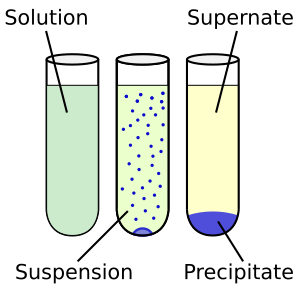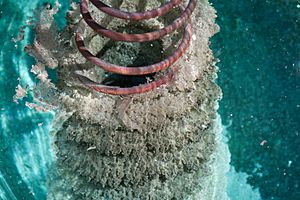Chemical precipitation facts for kids
Precipitation is a cool science process where a solid forms inside a liquid solution. Imagine you mix two clear liquids, and suddenly, tiny solid bits appear! These solid bits are called the precipitate. The chemical that makes this solid appear is known as the precipitant.
When the solid forms, it might float around in the liquid for a bit. This is called being in suspension. If there's enough gravity, or if you spin the liquid really fast in a special machine called a centrifuge, these solid particles will settle down. They can even form a compact mass at the bottom, which scientists sometimes call a 'pellet'. The clear liquid left above the solid is called the 'supernatant'.
Sometimes, people used to call powders made this way 'flowers'. If the solid is made of cellulose fibers that have been chemically treated, the process is often called regeneration.
How Precipitation is Used
Precipitation reactions are super useful in many ways! They help us make colorful pigments for paints and dyes. Think about how many colors we see every day – some of them might have been made using precipitation!
This process is also very important for cleaning water. For example, it can help remove unwanted salts or other impurities from water, making it safer to drink or use. This is a big part of water treatment plants.
In the world of metallurgy, which is the science of metals, precipitation can make metals stronger. When tiny solid particles form within a metal alloy, they can make the material much tougher and more durable. This is a clever way to improve how metals work!
Images for kids
See also
 In Spanish: Precipitado para niños
In Spanish: Precipitado para niños





